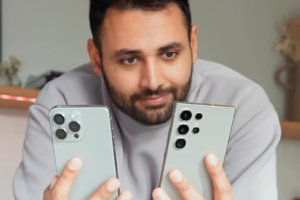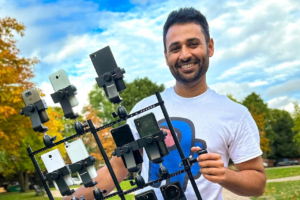Mr. Who’s The Boss stands as a testament to the enduring power of measured expertise and authentic connection. With over 21 million subscribers hanging on his every word about the latest technological innovations, Arun has carved out a unique space in the crowded landscape of tech YouTube—one where thorough analysis meets accessible explanation, and where the pursuit of excellence doesn’t preclude the search for peace.
Seated in his meticulously designed home studio, surrounded by the latest gadgets that serve as both tools of his trade and subjects of his scrutiny, Arun presents a striking contrast to the archetypal image of the perpetually hustling content creator. His presence carries the quiet confidence of someone who has found their calling, yet his words reveal the complex reality of maintaining that position. “There’s two sides to me,” he reflects, his voice carrying the weight of experience. “There’s a side to me that seeks peace and there’s a side to me that is wildly ambitious and those two sides are constantly fighting with each other.”
This internal dialogue between ambition and tranquility isn’t merely philosophical—it manifests in the very fabric of his content creation process. Each video, meticulously crafted and precisely delivered, represents hours of unseen labor, late nights, and the kind of attention to detail that has become increasingly rare in the age of rapid-fire content. Yet unlike many of his contemporaries who wear their 80-hour workweeks as badges of honor, Arun speaks openly about the toll of such dedication. “I am burnt out most days of the week currently,” he admits, not as a complaint but as a matter of fact, highlighting the often-unseen cost of digital excellence.
But perhaps what sets Arun apart isn’t just his technical expertise or his ability to break down complex concepts for his audience—it’s his willingness to evolve while staying true to his core principles. In an industry where the next big thing is always around the corner, he has maintained a remarkable consistency in quality while adapting to changing platforms and audience preferences. His approach to short-form content, for instance, demonstrates a masterclass in adaptation without compromise—bringing the same level of insight and production value to shorter formats that his audience has come to expect from his long-form content.
The conversation with Arun reveals something crucial about the nature of digital influence in 2024: that sustainable success in this space isn’t just about keeping up with the latest trends or having the newest gadgets. It’s about finding that elusive balance between pushing boundaries and maintaining sanity, between feeding the algorithm and nourishing the soul. His journey from tech enthusiast to trusted authority hasn’t been without its challenges, but it’s precisely these challenges that have shaped his unique perspective on the intersection of technology, content creation, and personal fulfillment.

As the tech landscape continues to evolve at a breakneck pace, with AI, AR, and other emerging technologies reshaping our digital existence, creators like Arun serve as crucial guides—not just in understanding the technical specifications of our devices, but in navigating the human experience of living with them. His story reminds us that at the heart of every piece of technology is a human story, and at the core of every successful creator is a constant negotiation between growth and sustainability.
In the serene setting of his newly acquired home, where ambient light filters through carefully chosen windows and the distant hum of London life feels worlds away, Mr. Who’s Boss (Arun) confronts a paradox familiar to many digital creators: the relentless pursuit of content excellence versus the fundamental human need for peace. It’s a dichotomy that manifests itself in the very rhythm of his daily life, where 11 PM finishes have become the norm rather than the exception.
“I am burnt out most days of the week currently ”
he admits with a candor that cuts through the perfectly curated facade of social media success. This revelation comes not from a place of complaint but rather as a matter of fact, delivered with the knowing smile of someone who has chosen their path with eyes wide open. The admission carries particular weight coming from a creator who has mastered the art of tech reviews, amassing over 21 million subscribers through a combination of technical precision and engaging presentation.
The current challenge weighing on Arun’s mind exemplifies this eternal struggle. He’s undertaken an ambitious project to document the transformation of his new home, committing to weekly videos about each room’s renovation. It’s the kind of content that audiences dream about—a behind-the-scenes look at creating the perfect creative space. Yet the reality of this dream project reveals the hidden costs of content creation: “The construction takes way longer than they told us it would take, so we’re still committing to our weekly timelines while other things are all spilling over.”
This situation illuminates a broader truth about content creation in 2024: the opportunities are abundant, perhaps too abundant. Arun describes a peculiar form of professional torture—the constant arrival of exciting opportunities that you feel “stupid for not taking,” even as your calendar screams for mercy. It’s a sentiment that resonates across the creator economy, where the fear of missing out collides with the very real limits of human endurance.
The pursuit of balance in this context becomes less about achieving perfect equilibrium and more about making peace with perpetual motion. Arun’s approach to this challenge is refreshingly pragmatic. Rather than chasing the myth of perfect work-life balance, he’s learning to redefine success in terms of sustainability. “My goal, if you ask me what my actual vision is,” he reflects, “I would love to never hit burnout ever again. That would be success in my eyes.”
This redefinition of success represents a maturing of the creator economy. Where once the narrative centered on hustle culture and astronomical growth, conversations now turn to longevity and mental health. It’s a shift that acknowledges a fundamental truth: the most impressive feat isn’t in pushing yourself to the limit, but in finding a pace you can maintain indefinitely.

Yet the reality of maintaining this balance remains complex. When asked about taking breaks, Arun reveals he hasn’t taken one since starting his channel in 2011. The fear of algorithmic abandonment—of losing the audience’s attention during even a brief hiatus—creates a perpetual pressure to produce. This pressure points to a larger conversation about the sustainability of content creation as a career, and the structures needed to support creators in maintaining their mental and physical health.
The pursuit of balance, then, becomes not just a personal quest but a professional imperative. As Arun navigates these waters, his experience offers valuable insights for creators at all levels: the importance of defining success on your own terms, the courage to acknowledge burnout, and the wisdom to seek sustainability over short-term gains. In the end, perhaps the true art lies not in achieving perfect balance, but in learning to dance gracefully with its absence.
The landscape of digital content creation has undergone a seismic shift since the advent of short-form video, and few creators understand this evolution better than Mr. Who’s Boss. From his vantage point as one of tech YouTube’s most influential voices, Arun has witnessed—and helped shape—the platform’s transformation from long-form haven to multimedia ecosystem.
“We got lucky because we got on it early”
Arun reflects on his channel’s adaptation to short-form content, his voice carrying the measured wisdom of someone who’s navigated multiple platform transitions. This early adoption proved transformative, though not in the ways one might expect. While the financial returns from shorts remained modest compared to traditional videos, the format opened up unprecedented access to new audiences. “The number of young kids who came up to me and said ‘I watch your shorts’—they didn’t even know we made long-form content,” he notes, highlighting the generational divide in content consumption.
This shift represents more than just a change in video length; it signals a fundamental transformation in how audiences engage with content. The emergence of short-form video has created what Arun describes as a bifurcation in the content landscape: “I think what you mean is the element of short content just being present and affecting global psychology so deeply that now all long-form content either has to cater to that short-form oriented mind or heal it.”
This observation cuts to the heart of modern content strategy. The middle ground—those five-minute YouTube videos that once formed the backbone of the platform—has largely disappeared, leaving creators to navigate between one-minute shorts and twenty-minute-plus deep dives. It’s a polarization that reflects broader changes in audience attention spans and consumption habits.
Yet amidst this evolution, Arun maintains a nuanced perspective on the role of different content formats. He views short-form content as a powerful tool for understanding audience preferences and developing creator instincts. “For any content creator just starting out,” he advises, “I’d say that not longer than one year should be dedicated to short content only.” This time limit reflects both the format’s value as a learning tool and its limitations as a sole content strategy.

The impact of this shift extends beyond mere metrics. It has fundamentally altered the relationship between creators and their audience. While short-form content excels at building awareness and reaching new viewers, the depth and connection fostered through long-form content remain irreplaceable. This duality presents both challenges and opportunities for creators seeking to build sustainable platforms.
Looking ahead, Arun sees the future of content creation not in choosing between formats but in understanding their distinct roles in the creator ecosystem. Short-form content serves as an entry point, a way to capture attention in an increasingly crowded digital landscape. Long-form content, meanwhile, provides the depth and substance that transform casual viewers into engaged community members.
This evolution has also sparked a broader conversation about the nature of content consumption and its impact on society. As Arun notes, the presence of short-form content has created a need for content that either adapts to or counteracts its influence on attention spans. This dynamic presents creators with a unique challenge: how to maintain engagement while fostering deeper connections with their audience.
The lesson here isn’t about abandoning one format for another but rather understanding how different content types serve distinct purposes in a creator’s arsenal. As platforms continue to evolve and new formats emerge, the ability to adapt while maintaining authenticity and quality will remain crucial for long-term success in the digital content space.
There’s a particular irony in the journey of a tech reviewer—a path that transforms the excitement of unboxing new devices into the methodical routine of professional analysis. For Mr. Who’s Boss, this evolution is captured in a single, poignant reflection about receiving new phones: “There was a phase in my life where I would be buzzing when I knew there was a phone waiting for me at home… Now it is work. A new phone comes in and I think: that’s my next three days gone.”
This transformation from enthusiast to authority figure tells a larger story about the professionalization of passion in the digital age. In his early days, Arun recalls the pure anticipation of racing home from school, impatient with traffic, eager to unwrap the latest device. That youthful excitement has matured into something more nuanced—a deep appreciation for technology’s role in shaping our future, tempered by the responsibility of guiding millions through their tech decisions.
When discussing the future of smartphone technology, Arun’s perspective is refreshingly grounded. “The reason things aren’t changing very much in the last few years is because it’s really good,” he observes, cutting through the industry’s perpetual hype cycle. His analysis of the current smartphone form factor—”perfectly easy to hold, the battery lasts all day, you can consume your content, you can use your social apps”—speaks to a broader truth about technology: sometimes, perfection lies in refinement rather than revolution.

This pragmatic viewpoint extends to his analysis of emerging technologies like AR and VR. While others rush to pronounce these as the next big thing, Arun points to fundamental human behaviors that need to be considered. “There’s something so beautiful about a phone that you can put away and then you can take out,” he reflects, highlighting how the physical interaction with our devices has become deeply ingrained in our daily rituals. This observation cuts to the heart of why certain technologies succeed while others struggle to find their place in our lives.
His perspective on Apple’s evolution is equally nuanced. Drawing from years of observation, he notes how the company has mastered the art of premium positioning: “They’re a premium desirable brand and they specifically never even put themselves on sale unlike every other phone company.” This strategy, he explains, has protected their brand value while positioning them perfectly for a world of rising incomes and growing middle classes.
Yet beneath these market analyses lies a deeper understanding of technology’s human impact. When discussing innovation, Arun points to the importance of solving real problems rather than creating solutions in search of problems. This philosophy is evident in his approach to reviewing products—focusing not just on specifications and features, but on how they fit into people’s lives.
The future of consumer technology, in Arun’s view, isn’t about radical transformation but thoughtful evolution. While AR and VR technologies continue to develop, he predicts a gradual transition similar to the iPhone’s home button evolution—where new technologies coexist with familiar formats until users are ready to make the shift. This measured perspective comes from years of watching technology cycles unfold, understanding that true innovation isn’t just about technical capability but about matching human readiness and need.
What emerges from these reflections is a portrait of someone who has maintained their love for technology while developing a deeper understanding of its role in society. The excitement of unboxing new devices may have transformed into professional routine, but it’s been replaced by something more valuable—the ability to see beyond the surface of innovation to its human impact and implications.
In the gleaming world of digital content creation, where success is often measured in views and subscribers, the path to building a sustainable business remains remarkably opaque. For Mr. Who’s Boss, whose journey spans over a decade of tech reviews and 21 million subscribers, the challenge isn’t just maintaining relevance—it’s transforming fleeting attention into lasting value.
“Over the course of the last 9 years, I’ve realized that a YouTuber has to go from just doing influencer marketing to building something else”
His voice carrying the weight of hard-won experience. This evolution from content creator to business architect represents a crucial pivot point in the creator economy, where the limitations of platform dependency become increasingly apparent.
The journey beyond traditional revenue streams presents a unique set of challenges for creators. As Arun notes, “We have spent probably 6 to 7 years trying to figure out what the next step is for the channel.” This extended period of exploration reveals a fundamental truth about creator businesses: the path to sustainability isn’t always obvious, and what works for one creator may not work for another.
Perhaps most telling is Arun’s perspective on product development, an area where many creators rush to capitalize on their audience’s trust. “I have said countless times I will not make a product until I find something that I’m just obsessed with,” he emphasizes. This patient approach stands in stark contrast to the rapid-fire merchandising strategies often seen in the creator space. “We’re not product companies,” he explains. “We have not spent 10-15 years honing the craft of building a perfect product.”
This recognition of core competencies leads to a more nuanced approach to business development. Rather than attempting to become expert manufacturers overnight, Arun advocates for finding “the perfect synergy with another company who already has those capabilities and then use your channel as effectively like a marketing engine.” This strategy acknowledges both the strengths and limitations of creator-led businesses.
The challenge of scaling operations while maintaining quality presents another critical consideration. For Arun, this means being selective about opportunities and understanding that not every revenue stream is worth pursuing. He recounts nearly launching a podcast with another top Tech YouTuber, reaching the point of filming draft episodes, before realizing it didn’t align with his core goal of reducing filming time while maintaining output quality.

One particularly innovative approach to sustainable growth emerges in Arun’s discussion of team building. “My main gauge for success is my ability to create jobs,” he shares, revealing a perspective that extends beyond personal gain to community impact. This approach not only creates a more sustainable business model but also contributes to the broader creator economy ecosystem.
The evolution of revenue streams in the creator economy follows a familiar pattern: starting with platform monetization (AdSense), moving to influence marketing, and ultimately seeking exponential growth through business ventures. However, Arun’s experience suggests that linear growth, when sustainable, may be preferable to the risks and pressures of seeking exponential returns.
Perhaps most critically, Arun’s approach to business development emphasizes the importance of maintaining authenticity while pursuing growth. “The channel will be a priority for a very long time if not forever,” he asserts, highlighting the delicate balance between building new ventures and nurturing the core content that built his audience in the first place.
This long-term view of sustainability challenges the prevalent “grow at all costs” mentality in the creator economy. It suggests that true sustainability comes not from chasing every opportunity, but from carefully selecting ventures that align with both creator capabilities and audience expectations. In an industry often characterized by its frenetic pace, this measured approach to business building offers a compelling alternative path to lasting success.
In the quiet moments between takes, when the ring lights dim and the latest gadgets are tucked away, Mr. Who’s Boss reveals a side of himself rarely glimpsed by his millions of subscribers. Here, in the peaceful confines of his newly established home, Arun speaks not of megapixels or processing power, but of the intricate dance between personal fulfillment and professional success.
The foundation of his life beyond the camera rests on a partnership that bridges both personal and professional realms. Having met his wife Drisha through a dating app—a fact he notes with a touch of wonder at how technology has transformed human connection—their relationship has evolved into a sophisticated collaboration that extends from life to work. “We get to spend all hours of every single day together because we work together, we live together, we’re married together,” he reflects, his voice carrying both gratitude and awareness of the unique dynamics this creates.
Their working relationship exemplifies the beauty of complementary strengths. Where Arun’s YouTube background brought an unstructured creativity, Drisha’s corporate experience introduced valuable structure. “She creates notion templates and big slack messages with bullet points,” he explains, a hint of admiration in his voice for the organization she brings to their shared endeavors. This synthesis of approaches has proved transformative, reducing his workweek from an unsustainable 88 hours to a more manageable 60—a testament to the power of partnership in creating sustainable success.
Gaming emerges as another crucial element of their shared life, offering a space for connection that transcends the pressures of content creation. Their gaming room, complete with extendable screens descending from the ceiling, represents more than just entertainment—it’s a childhood dream realized and a space for competitive bonding. A board on their wall keeps track of their gaming victories, blue pins for his wins, pink for hers, transforming play into a living record of their shared experiences.
Yet beneath these moments of joy lies a deeper conversation about future plans and family life. When discussing the prospect of children, Arun approaches the topic with characteristic thoughtfulness. “Every time I meet someone who’s had kids, I tend to find a way to ask them like was it a good decision, are you happy with it,” he shares, acknowledging the inherent bias in such inquiries while still seeking authentic insights. His reflection on timing—that the older you get, the more you wish you’d had children younger—reveals a nuanced understanding of life’s temporal nature.
The management of mental health in the spotlight presents its own unique challenges. “Your failures are very public,” Arun notes, touching on a vulnerability familiar to many creators. This awareness of constant scrutiny has led him to develop a daily practice of gratitude with Drisha, listing five things they’re thankful for before bed. It’s a simple ritual that serves as an antidote to the pressures of public life.
Perhaps most revealing is his perspective on relationships’ role in personal growth. “When you’re in a stable relationship, your insecurities reduce automatically,” he observes, describing how partnership provides a foundation that professional success alone cannot build. This insight speaks to a broader truth about the creator lifestyle—that external validation, no matter how abundant, cannot replace the security of genuine connection.
Looking toward the future, Arun’s vision extends beyond content milestones to life’s deeper purposes. The potential transition to parenthood isn’t viewed merely as a personal choice but as part of a larger conversation about legacy and purpose. “Something’s got to give,” he acknowledges when discussing how children might impact content creation, demonstrating a willingness to adapt his professional life to accommodate personal growth.
In these reflections, we see a portrait of someone actively working to build a life that transcends the boundaries of digital fame. It’s a reminder that even in the age of constant content, the most meaningful stories often unfold when the cameras stop rolling.
In the ever-evolving landscape of digital content creation, where success is often measured in metrics and algorithms, Mr. Who’s Boss presents a compelling alternative narrative—one that prioritizes sustainability over spectacle, authenticity over acceleration, and human connection over hollow engagement. Through our extended conversation, a portrait emerges not just of a tech reviewer at the height of his influence, but of a thoughtful navigator charting a course through the complexities of modern digital life.
The journey from excited tech enthusiast racing home to unbox the latest gadget to measured industry authority provides more than just a career trajectory—it offers a lens through which to view the maturation of the entire creator economy. Arun’s evolution mirrors the broader transformation of content creation from passionate hobby to professional pursuit, complete with all the challenges and opportunities such a transition entails.
Perhaps most striking is his nuanced approach to balance, not as a destination to be reached but as an ongoing negotiation between competing desires. The constant dance between ambition and peace, between scaling up and scaling back, reflects a deeper truth about success in the digital age: that sustainable growth often requires us to resist the very opportunities we once craved. This wisdom, earned through years of navigating the demands of platform algorithms and audience expectations, offers valuable insights for creators at all stages of their journey.
His perspective on technology itself has evolved in parallel, from wide-eyed wonder to measured appreciation. In an industry that thrives on hype cycles and planned obsolescence, Arun’s recognition that sometimes “it’s really good” because it’s “perfectly easy to hold” cuts through the noise with refreshing clarity. This ability to appreciate refinement over revolution, to value human needs over technical specifications, speaks to a deeper understanding of technology’s role in our lives.
The personal dimensions of his story—finding love through a dating app, building a shared life that seamlessly blends work and play, maintaining family connections while building a global brand—remind us that even in our increasingly digital world, human connections remain the foundation of a life well-lived. His candid discussions about mental health, burnout, and the challenge of maintaining authenticity under public scrutiny offer crucial insights for anyone navigating the intersection of personal and professional life in the digital age.
Looking ahead, Arun’s vision for the future—both personal and professional—suggests a path forward that others might emulate. It’s a future where success is measured not just in subscribers and views, but in the ability to create meaningful impact, whether through job creation, honest product reviews, or simply sharing authentic experiences. His approach to potential parenthood, viewed through the same thoughtful lens he applies to technology, reveals a characteristic blend of research, reflection, and genuine curiosity about life’s next chapters.
As the creator economy continues to evolve, with new platforms emerging and audience behaviors shifting, the lessons drawn from Arun’s journey become increasingly valuable. His story suggests that lasting success in the digital age isn’t built on algorithmic mastery alone, but on the ability to maintain humanity amidst the endless scroll, to find peace amid the persistent push for more, and to build genuine connections in an increasingly virtual world.
In the end, Mr. Who’s Boss offers us more than just tech reviews—he provides a masterclass in navigating the complexities of modern digital life while keeping sight of what truly matters. His journey reminds us that in the pursuit of digital excellence, our most valuable upgrades might just be the ones that make us more human, not less.


